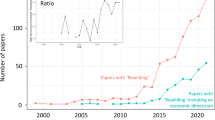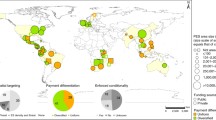Abstract
Natura 2000 sites are expected to assure the long-term survival of Europe’s most valuable and threatened species and habitats. It follows that successful management of the sites is of great importance. Next to goal attainment, cost-effectiveness is increasingly recognised as a key requirement for gaining social and political acceptance for costly conservation measures. We identify and qualitatively examine issues of cost-effectiveness related to the design and implementation of management measures in Natura 2000 sites in Finland, Germany, the Netherlands and Poland. Given the wide variety of management design and implementation options within the four countries, our study is purely of an exploratory nature. We derive recommendations for improving the cost-effectiveness of management in Natura 2000 sites and for future research. Examples of policy recommendations include guaranteeing the availability of funds for longer periods, and ensuring the appropriate allocation of funds between the different tasks of designing and implementing management plans. Further research should examine the cost-effectiveness of controversial suggestions such as, for example, more tailored payment schemes for conservation measures that result in higher ecological outputs but are costly to administer. Moreover, more research is needed to better understand how rules for administrations, as well as rules and governance structures for tasks within administrations, should be designed.
Similar content being viewed by others
References
Ando A, Camm J, Polasky S, Solow A (1998) Species distributions, land values, and efficient conservation. Science 279:126–2128
ANFQ (Ministry of Agriculture, Nature, Food Quality) (2006) Natura 2000 targets document summary. Setting conservation objectives for the Natura 2000 network in the Netherlands. Ministry of Agriculture, Nature and Food Quality, The Hague
BfN (Federal Nature Conservation Agency) (2007a) http://www.bfn.de/0316_natura2000.html. Cited 10 Feb 2010
BfN (Federal Nature Conservation Agency) (2007b) http://www.bfn.de/0316_gebiete.html. Cited 10 Feb 2010
BfN (Federal Nature Conservation Agency) (2008) http://www.bfn.de/0316_finanzen.html, Finanzierung von Natura 2000 Leitfaden, also available in English (and 20 other EU member state languages), http://ec.europa.eu/environment/nature/natura2000/financing/index_en.htm. Cited 10 Feb 2010
Birds Directive (1979) Council Directive 79/409/EEC of 2 April 1979 on the conservation of wild birds. http://eur-lex.europa.eu/LexUriServ/LexUriServ.do?uri=CELEX:31979L0409:EN:HTML. Cited 10 Feb 2010
Birner R, Wittmer H (2004) On the efficient boundaries of the State—the contribution of transaction costs economics to the analysis of decentralization and devolution in Natural Resource Management. Environment and Planning C: Government and Policy 22(5):667–685
Buitelaar E (2004) A transaction-cost analysis of the land development process. Urban Studies 41(13):2539–2553
Cabeza M, Moilanen A (2006) Replacement cost: a practical measure of site value for cost-effective reserve planning. Biol Conserv 132:336–342
Chmielewski TJ (1994a) Principles of developing nature conservation plans for landscape parks. Methodological and organisational recommendations (in Polish). Ministerstwo Ochrony Środowiska, Zasobów Naturalnych i Leśnictwa, Warszawa
Chmielewski TJ (ed) (1994b) National park conservation plans. A manual (in Polish). Ministerstwo Ochrony Środowiska, Zasobów Naturalnych i Leśnictwa; Krajowy Zarząd Parków Narodowych, Warszawa
Chmielewski TJ (ed) (2004) Problems with organization and function of Natura 2000 network in Poland. (in Polish, English summary) Zeszyty Naukowe Komitetu “Czlowiek i Srodowisko” przy Prezydium PAN, Nr 38; Warszawa-Lublin
Chmielewski TJ (ed) (2006a) Nature resources management in Natura 2000 areas in Poland (in Polish, English summary). Wydawnictwo Akademii Rolniczej w Lublinie, Lublin
Chmielewski TJ (2006b) The integrated cost-effectiveness analysis of nature conservation as an instrument of Natura 2000 sites management (in Polish, English summary). In: Chmielewski TJ (ed) Nature resources management in Natura 2000 areas in Poland. Wydawnictwo Akademii Rolniczej w Lublinie, Lublin, pp 32–40
Chmielewski TJ (ed) (2007) Nature conservation management: from idea to practical results. European Commission 6th Framework Program: ALTER-Net. PWZN Print 6. Lublin-Lódz-Helsinki-Aarhus
Chmielewski TJ (2008) Landscape and protected areas—Polish experiences. In: Schmidt M, Glasson J, Emmelin L, Helbron H (eds) Standards and thresholds for impact assessment. Series: environmental protection in the European Union, vol 3. Springer, Berlin, pp 315–326
Chmielewski TJ, Gromadzki M, Jankowski W, Kistowski M (2006) The role of Natura 2000 areas network in the formation of the new nature conservation paradigm in Poland (in Polish, English summary). In: Chmielewski TJ (ed) Zarządzanie zasobami przyrody na obszarach Natura 2000 w Polsce. Wydawnictwo Akademii Rolniczej w Lublinie, Lublin, pp 6–12
COM (2004) Communication from the Commission to the Council and the European Parliament. Financing Natura 2000. Commission of the European Communities: COM (2004) 431 final. Brussels
De Jong JJ, Bouwma IM, Van Wijk MN (2007) Beheerskosten van Natura 2000-gebieden. Wageningen, Wettelijke Onderzoekstaken Natuur & milieu, Wot-werkdocument 56
Drechsler M (2005) Probabilistic approaches to scheduling reserve selection. Biol Conserv 122:253–262
Drechsler M, Johst K, Ohl C, Wätzold F (2007a) Designing cost-effective payments for conservation measures to generate spatiotemporal habitat heterogeneity. Conserv Biol 21(6):1475–1486
Drechsler M, Wätzold F, Johst K, Bergmann H, Settele J (2007b) A model-based approach for designing cost-effective compensation payments for conservation of endangered species in real landscapes. Biol Conserv 140:174–186
DVL (Deutscher Verband für Landschaftspflege) (2005) Managementpläne – Schlüssel für eine kooperative Umsetzung von Natura 2000. Vier Anforderungen aus Sicht des DVL, Ansbach
Eben M (2006) Public Participation during Site Selections for Natura 2000 in Germany: The Bavarian Case. In: Stoll-Kleemann S, Welp M (eds) Stakeholder dialogues in natural resources management, Part III. Environmental Science and Engineering Subseries: Environmental Science, Springer, Berlin
European Commission (2008) http://ec.europa.eu/environment/nature/natura2000/barometer/index_en.htm. Cited 10 Feb 2010
Ferraro P, Pattanayak SK (2006) Money for nothing? A call for empirical evaluation of biodiversity conservation investments. PLOS Biol 4(4):0482–0488
Finnish Ministry of the Environment (2002) Natura 2000 – alueiden hoito ja käyttö (Management of Natura 2000 sites). Työryhmän mietintö. Suomen ympäristö 597. Ympäristöministeriö, Helsinki
Finnish Ministry of the Environment (2003) National priorities in planning of management of Natura 2000 sites. Letter to the regional environmental centres
Finnish Ministry of the Environment (2004) Natura 2000 – verkoston tavoitteet, oikeusvaikutukset ja toteuttaminen (Natura 2000 network – objectives, legal consequences and implementation). Ympäristöministeriö, Alueidenkäytön osasto. Helsinki. http://www.ymparistokeskus.fi/download.asp?contentid=23493&lan=fi. Cited 10 Feb 2010
Grzesiak M, Domanska W (eds) (2006) Environment protection in Poland, 2006. Information and statistical analyses (in Polish). Główny Urząd Statystyczny, Warszawa
Habitats Directive (1992) Council Directive 92/43/EEC of 21 May 1992 on the conservation of natural habitats and of wild fauna and flora. http://eur-lex.europa.eu/LexUriServ/LexUriServ.do?uri=CELEX:31992L0043:EN:HTML . Cited 10 Feb 2010
Hagedorn K (ed) (2002) Environmental cooperation and institutional change: theories and policies for European agriculture. Edward Elgar, Cheltenham
Hartmann E, Schekahn A, Luick R, Thomas F (2006) Kurzfassungen der Agrarumwelt- und Naturschutzprogramme – Darstellung und Analyse von Maßnahmen der Agrarumwelt- und Naturschutzprogramme in der Bundesrepublik Deutschland. BfN-Skripten 161, Bonn
Hiedanpää J (2002) European-wide conservation versus local well-being: the reception of the Natura 2000 Reserve Network in Karvia, SW-Finland. Landsc Urban Plan 61:113–123
Hiedanpää J (2005) The edges of conflict and consensus: a case for creativity in regional forest policy in Southwest Finland. Ecol Econ 55:485–498
Holzkämper A, Seppelt R (2007) Evaluating cost-effectiveness of conservation management actions in an agricultural landscape on a regional scale. Biol Conserv 136:117–127
Horn R, Simon L, Ströger L, Unkel I (2008) Rheinland-Pfalz – Entwicklung der neuen Kennartenprogramme zur erfolgsorientierten Honorierung von Grünland. Natur und Landschaft 5:206
Johst K, Drechsler M, Wätzold F (2002) An ecological-economic modelling procedure to design compensation payments for the efficient spatio-temporal allocation of species protection measures. Ecol Econ 41:37–49
Kleijn D, Berendse F, Smit R, Gilissen N (2001) Agri-environment schemes do not effectively protect biodiversity in Dutch agricultural landscapes. Nature 413:723–725
Klimek S, gen Richter, Kemmermann A, Steinmann HH, Freese J, Isselstein J (2008) Rewarding farmers for delivering vascular plant diversity in managed grasslands: a transdisciplinary case-study approach. Biol Conserv 141:2888–2897
Kostrzewski A (ed) (1993) Integrated monitoring on natural environment in Poland (in Polish). Państwowa Inspekcja Ochrony Środowiska. Biblioteka Monitoringu Środowiska, Warszawa
Kostrzewski A, Stach A (eds) (1992) Local (field) stations for natural environment monitoring in Poland (in Polish). Państwowa Inspekcja Ochrony Środowiska. Biblioteka Monitoringu Środowiska, Warszawa
Lehmann P, Schleyer C, Wätzold F, Wüstemann H (2009) Promoting multifunctionality of agriculture: an economic analysis of new approaches in Germany. J Environ Policy Plan 11(4):315–332
Leneman H, Graveland C (2004) Deelnamebereidheid en continuiteit van het Agrarisch Natuurbeheer. Report 7.04.06. LEI, Den Haag
Lindlof TR, Taylor BC (2002) Qualitative communication research methods, 2nd edn. SAGE, Thousand Oaks
Millennium Ecosystem Assessment (2005) Ecosystems and human well-being: policy responses: findings of the responses working group of the Millenium Ecosystem Assessment. Island Press, Washington (D.C.)
MRL BW (Ministry of Nutrition and Rural Areas Baden-Wuerttemberg) (2008) http://www.mlr.baden-wuerttemberg.de/content.pl?ARTIKEL_ID=11450. Cited 10 Feb 2010
National Audit Office (2007) Natura 2000 verkon valmistelu (Preparation and designation of Natura 2000 network). Tarkastuskertomus 140/2007. Valtiontalouden tarkastusvirasto, Helsinki
NCA (Nature Conservation Act of 16th April) (2004) Dziennik Ustaw 04.92.880, with subsequent revisions (in Polish)
Netherlands Environmental Assessment Agency (2007) Executive summary: Ecological Evaluation of Nature Conservation Schemes run under the Stewardship Programme and the Dutch National Forest Service 2000–2006. Netherland Environmental Assessment Agency (MNP), Bilthoven
Netherlands Environmental Assessment Agency (2009) Natuurbalans 2009. PBL publication 500402017, Bilthoven
Newig J, Fritsch O (2009) Environmental governance: participatory, multi-level—and effective? Environ Policy Gov 19:197–214
Ojala O (2007) Natura 2000 – alueiden hoidon ja käytön yleissuunnitelma. Uusimaa ja Itä-Uusimaa (Natura 2000 sites management in the counties of Uusimaa and Itä-Uusimaa). Uudenmaan ympäristökeskuksen raportteja 3/2007. http://www.ymparisto.fi/download.asp?contentid=67868. Cited 10 Feb 2010
Olaczek R (1996) Instructions for the development of nature preserve management plans (in Polish). Ministerstwo Ochrony Środowiska. Zasobów Naturalnych i Leśnictwa, Warszawa
Ostrom E (2005) Understanding institutional diversity. Princeton University Press, Princeton, New Jersey
Paavola J, Gouldson A, Kluvánková-Oravská T (2009) Interplay of actors, scales, frameworks and regimes in the governance of biodiversity. Environ Policy Gov 19:148–158
Penker M (2000) Vertragsnaturschutz in Österreich – Bestandsaufnahme seiner praktischen Handhabung sowie Maßnahmen des Verwaltungscontrollings für eine ökonomisch effiziente und ökologisch effektive Mittelallokation. Dissertation am Institut f. Agrarökonomik der Universität für Bodenkultur Wien
Reiter K, Schmidt A, Stratmann U (2004) „ … Grünlandnutzung nicht vor dem 15.Juni …” Sinn und Unsinn von behördlich verordneten Fixterminen in der Landwirtschaft, BfN-Skripten 124, Bonn
Statistics Finland (2006) Luonnonvarat ja ympäristö 2006 (Statistical report on environmental protection and natural resources 2006). Tilastokeskus, Helsinki
Stoll-Kleemann S, Welp M (eds) (2006) Stakeholder dialogues in natural resources management. Springer, Berlin
Suda M, Sauer A, Luz F, Dettweiler G, Beck R (2005) FFH – Schlüssel zur Kooperation oder Motor von Konflikten. BfN-Skripte 159, Bonn
Wätzold F, Schwerdtner K (2005) Why be wasteful when preserving a valuable resource? A review article on the cost-effectiveness of European biodiversity conservation policy. Biol Conserv 123:327–338
Whitby M, Saunders C (1996) Estimating the supply of conservation goods in Britain. Land Econ 72:313–325
Witzel A (2000) Das problemzentrierte Interview. Forum Qualitative Sozialforschung/Forum, Qualitative Social Research 1(1)
Zabel A, Roe B (2009) Optimal design of pro-conservation incentives. Ecol Econ 69(1):126–134
Acknowledgements
The work of this paper has been made possible by the EU FP6 Network of Excellence ALTER-Net (EU grant GOCE-CT-2003-505298-Alternet). We are grateful to two anonymous reviewers for detailed and helpful comments and to Amrei Aigner for helping us with the manuscript layout.
Author information
Authors and Affiliations
Corresponding author
Rights and permissions
About this article
Cite this article
Wätzold, F., Mewes, M., van Apeldoorn, R. et al. Cost-effectiveness of managing Natura 2000 sites: an exploratory study for Finland, Germany, the Netherlands and Poland. Biodivers Conserv 19, 2053–2069 (2010). https://doi.org/10.1007/s10531-010-9825-x
Received:
Accepted:
Published:
Issue Date:
DOI: https://doi.org/10.1007/s10531-010-9825-x




